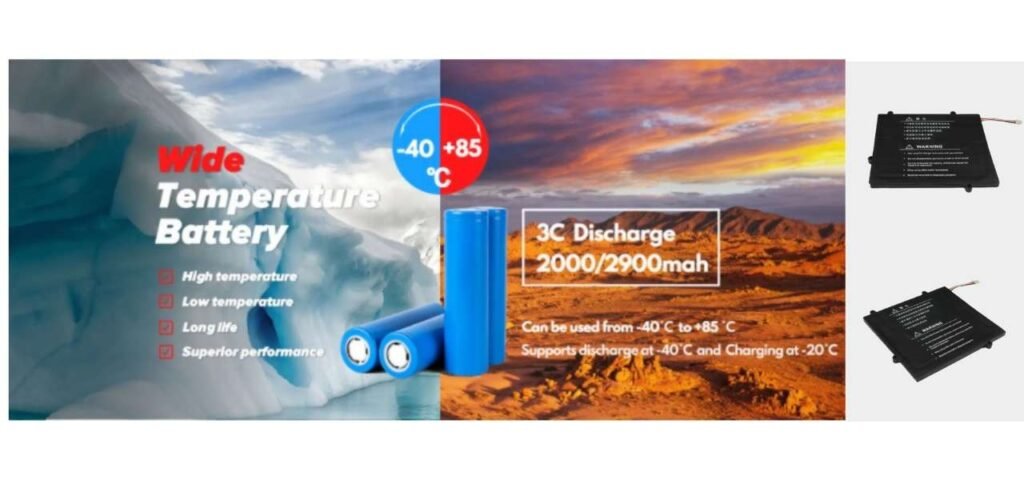Lithium-ion polymer (LiPo) batteries are widely used today due to their high energy density, lightweight design, and flexibility. They power everything from drones and smartphones to electric vehicles. However, questions about their safety often arise, especially given reports of battery overheating, swelling, and even fire in some cases. So, are LiPo batteries safe? The answer is both yes and no, depending on how they are used and handled.
In this guide, we will discuss the safety aspects of Lithium Ion Polymer batteries, common risks, and best practices to ensure safe usage.

Understanding Safety Concerns with Lithium Ion Polymer Batteries
While LiPo batteries are generally safe when used correctly, their high energy density and chemical composition make them vulnerable to certain risks if mishandled. Like all lithium-based batteries, LiPo batteries contain flammable electrolytes, and under certain conditions, they can become unstable. The most common safety issues associated with LiPo batteries include:
1. Overcharging
Overcharging is one of the primary risks associated with LiPo batteries. If a LiPo battery is charged beyond its maximum voltage (typically 4.2V per cell), it can cause the electrolyte to overheat, leading to swelling, leakage, or even fire. Using a charger that is not specifically designed for LiPo batteries can increase the risk of overcharging.
2. Over-discharging
Similarly, over-discharging a LiPo battery below its safe minimum voltage (usually around 3.0V per cell) can cause permanent damage to the battery. Over-discharged batteries are more likely to overheat during charging, possibly leading to dangerous situations such as thermal runaway, which can result in fires or explosions.
3. Physical Damage
A LiPo battery is sensitive to physical damage. Puncturing, crushing, or bending a LiPo battery can cause the internal structure to short-circuit, leading to overheating, swelling, or fire. Damaged batteries should be discarded immediately, even if they still hold a charge.
4. Exposure to High Temperatures
High temperatures can cause LiPo batteries to degrade, swell, or even ignite. Leaving a LiPo battery in a hot environment, such as inside a car on a sunny day, can accelerate chemical reactions inside the battery, leading to dangerous consequences.
5. Swelling (Puffed Batteries)
Swelling occurs when the internal chemical reactions inside the battery produce gas. This gas buildup causes the battery to expand, often referred to as “puffing.” A swollen battery is a sign that the battery is damaged and should not be used. Attempting to keep using a swollen battery can lead to rupture or fire.
Are LiPo Batteries Safe for Everyday Use?
Yes, LiPo batteries are safe for everyday use if proper precautions are followed. Billions of devices are powered by LiPo batteries every day without incidents. However, safety risks arise when the batteries are mishandled, misused, or damaged.
Manufacturers have incorporated numerous safety measures into devices that use LiPo batteries, such as battery management systems (BMS), which regulate charging and discharging to prevent over-voltage or deep discharge. As long as you follow the manufacturer’s guidelines and take proper care of the battery, LiPo batteries can be used safely in a wide range of applications.
Best Practices for Safe Use of Lithium Ion Polymer Batteries
To ensure the safe use of LiPo batteries, it’s essential to follow these best practices:
1. Use the Right Charger
Always use a charger specifically designed for LiPo batteries. These chargers are equipped with protections that prevent overcharging and ensure that each cell in multi-cell batteries is charged evenly. Balanced chargers are particularly important for multi-cell LiPo batteries, as they ensure each cell reaches the correct voltage without overcharging.
2. Monitor Charging
Never leave a LiPo battery charging unattended. Although rare, failures can happen during charging, and it’s important to be present to intervene if something goes wrong. It’s also recommended to charge LiPo batteries in a fireproof charging bag as an extra safety precaution.
3. Store in a Safe Place
When not in use, store LiPo batteries in a cool, dry place away from direct sunlight or heat sources. Ideally, they should be stored at around 50% charge if they won’t be used for an extended period. Never store them fully charged for long durations, as this can degrade the battery and increase the risk of swelling.
4. Avoid Physical Damage
Do not drop or puncture LiPo batteries. If a battery is dropped or physically damaged, it should be inspected for any signs of swelling or leakage. If any damage is detected, the battery should be disposed of safely.
5. Use Proper Disposal Methods
Never throw LiPo batteries in the garbage. Because they contain hazardous materials, they need to be disposed of at designated battery recycling centers. Many cities and electronics stores offer LiPo battery disposal services.
6. Avoid Extreme Temperatures
Avoid exposing LiPo batteries to extreme temperatures. High heat can cause the battery to swell or catch fire, while freezing temperatures can reduce its performance and lifespan. Always store and use LiPo batteries in environments within the temperature range specified by the manufacturer.
7. Handle Swollen Batteries with Care
If you notice that a LiPo battery has started to swell, stop using it immediately. Swollen batteries are unstable and should not be recharged or used in any device. Place the battery in a fireproof container and contact a local recycling center for safe disposal.
What Causes a Lithium Ion Polymer Battery to Fail?
While LiPo batteries are generally reliable, several factors can cause them to fail:
- Overcharging or over-discharging: Both of these can cause the internal chemicals to become unstable, leading to swelling or fire.
- Physical damage: Dropping, puncturing, or bending the battery can cause internal short circuits.
- Manufacturing defects: In rare cases, manufacturing defects can cause internal failures in LiPo batteries. This is why it’s crucial to purchase batteries from reputable manufacturers.
- Exposure to extreme temperatures: Both heat and cold can degrade the battery’s components, leading to failure over time.
How to Identify a Damaged Lithium Ion Polymer Battery
Knowing how to spot a damaged LiPo battery can help prevent accidents. Here are some common signs of a damaged battery:
- Swelling or puffing: A visibly swollen or puffed battery is a clear sign of internal damage and should not be used.
- Leaking: If a LiPo battery is leaking, it should be handled with extreme caution. Do not touch the liquid, and dispose of the battery safely.
- Cracks or punctures: Any physical damage to the battery’s casing, such as cracks or punctures, indicates that the battery is unsafe to use.
- Excessive heat: If the battery becomes excessively hot during use or charging, it may be failing internally.
If you notice any of these signs, stop using the battery immediately and follow proper disposal procedures.

Conclusion: Are Lithium Ion Polymer Batteries Safe?
In conclusion, LiPo batteries are safe when used and handled properly. They offer exceptional performance in terms of energy density, lightweight design, and flexibility, making them suitable for a wide range of devices. However, like any powerful technology, they come with certain risks that need to be managed.
By following best practices—such as using the correct charger, monitoring charging, and storing them correctly—you can greatly reduce the risks associated with LiPo batteries. Ensure that you handle them with care, and always pay attention to signs of damage or malfunction. When used responsibly, Lithium Ion Polymer batteries can provide safe and reliable power for your devices.
Guangdong Yungbang New Energy Co., Ltd. was established in June 2013. Currently, we have a factory covering an area of 18,000 square meters and employ over 500 staff members. We possess multiple independent intellectual property rights and are recognized as a national high-tech enterprise specializing in the research, development, design, production, and sales of lithium-ion battery cells and battery packs.
Our lithium battery products are widely used in various electronic products, including mobile phones/intercom/POS machine battery series, security-related series, remote sensing mapping, Bluetooth speakers, vehicle networking/internet of things product series, mobile power supply/back-up power supply, tablet/laptop battery series, AGV robot series, power tools/electric bicycles/electric tricycles/electric quadricycles battery series, and more.
Since our establishment, our products have passed UL, CE, FCC, UN, PSE, CQC certifications, and all series of products comply with EU RoHS standards. Our products are globally insured by Ping An Insurance Company of China. Through the unremitting efforts of all our employees, our products have been well received in more than 30 countries and regions worldwide, including Europe, America, and Japan.
FAQ
1. Can LiPo batteries catch fire?
Yes, LiPo batteries can catch fire if they are overcharged, physically damaged, or exposed to high temperatures. Following proper handling and charging practices minimizes this risk.
2. How long do LiPo batteries last?
On average, LiPo batteries last for about 300 to 500 charge cycles. Proper care, such as avoiding overcharging and deep discharges, can help extend their lifespan.
3. Is it safe to charge LiPo batteries overnight?
It is not recommended to leave LiPo batteries charging unattended, especially overnight. Always monitor the charging process to ensure the battery doesn’t overheat or malfunction.
4. Can I use a swollen LiPo battery?
No, you should never use a swollen LiPo battery. Swelling is a sign that the battery is damaged and poses a safety risk. It should be safely disposed of at a battery recycling center.
5. What should I do if my LiPo battery gets too hot?
If your LiPo battery becomes excessively hot during use or charging, stop using it immediately. Allow it to cool down in a safe, non-flammable area, and do not attempt to charge or use it again until the cause of the overheating is identified.

